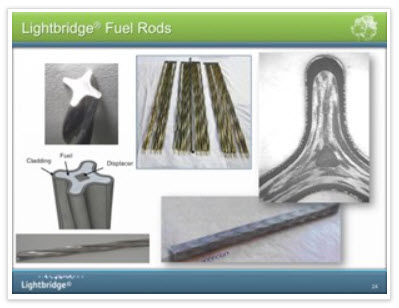September 30, 2014 – The beleaguered nuclear power industry may soon have a good story to tell post Fukushima. Lightbridge, a nuclear engineering company based in Virginia, is about to test a literal “twist” for fuel rods that can increase power yield by 10% in existing nuclear power plants with only minor modifications. And if the plants replace existing turbines with larger ones it would mean as much as a 17% increase in power output and incurring only an incremental investment without a major build.
The fuel, which resembles the licorice candy commonly known as Twizzlers, combines zirconium and uranium alloy in a spiral shape. Called a metallic fuel its twisty shape means the rods provide a 35 to 40% higher volume contact with the surrounding water in the pressurized chamber within the reactor. That means the heat dissipation into the surrounding water is much faster. The twisty design also means fewer fuel hot spots in the rods. But with the higher volumes of heat coming off the rods the pump technology needs to move the water in greater volume to distribute the heat. Does this metal fuel present a problem for the current design of pressurized reactors and does the higher water volume requirement for pump technology used in these plants mean additional increased costs?
“No” say the experts. The existing reactor designs can more than handle the heat dynamics and water flow requirements. That’s because two reasons.
First, the pumps in existing plants have been over engineered to handle volumes much larger than current loads. And second, the twisty-shaped fuel rods lower water resistance as it passes through them making circulation far more efficient.
The arguments for implementing the new fuel include:
- Metal fuel operates at far lower temperatures than uranium oxide fuels. Compare at 380 Celsius (716 Fahrenheit) degrees versus 1,500 Celsius (2,732 Fahrenheit).
- Next generation nuclear technology remains on the drawing boards and at least a decade away.
- Extending the life of existing nuclear plants and increasing their capacity lowers the cost of delivering energy and at the same time improves a utility’s carbon footprint. No need to build a natural gas-powered plant if you are getting the equivalent of one from increased power in an existing nuclear facility
- Metal fuels have been tested in American nuclear submarines and have been shown to safely work.
The drawbacks:
- the spent fuel storage problem remains unresolved by creating metallic fuel rods.
- reliance on this new fuel rod technology will probably lead to a slow down in the development of safer and smaller nuclear power options as the industry focuses on extending the life of its existing investments.
But for a power hungry world that is trying to address carbon-induced climate change, metal fuels may prove to be a better bridge answer than large scale investments in natural gas power plants.














“The beleaguered nuclear power industry may soon have a good story to tell post Fukushima.”
What?